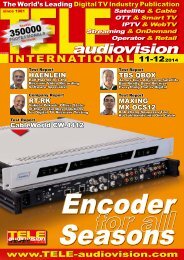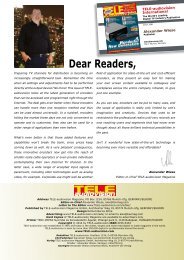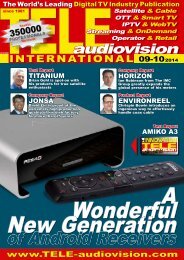eng TELE-audiovision 1305
The World’s Largest Digital TV Trade Magazine
The World’s Largest Digital TV Trade Magazine
You also want an ePaper? Increase the reach of your titles
YUMPU automatically turns print PDFs into web optimized ePapers that Google loves.
new<br />
from<br />
HISILIcon<br />
vitor Martins Augusto<br />
In the 11-12/2012 issue we reported<br />
on HISILICON‘s HI1376C.<br />
Now this SoC manufacturer has introduced<br />
additional versions to the<br />
market that would be incorporated<br />
in future receivers. We took a closer<br />
look at their specifications.<br />
„SoC“ stands for „System on Chip“.<br />
It‘s a chip that consists of not only the<br />
processor but also incorporates numerous<br />
other functions. Unlike a standard<br />
computer, with an SoC you don‘t need<br />
separate chips for audio and video interfaces,<br />
even USB and SD cards are<br />
linked directly to the SoC. This saves<br />
on costs and simplifies development.<br />
Receiver manufacturers can specifically<br />
implement the planned functions<br />
of their new receiver based on the<br />
matching SoC. HISILICON also offers<br />
reference layouts of the circuit boards<br />
so that the customer (receiver manufacturers)<br />
merely needs to add a tuner,<br />
front display and a remote control. Added<br />
to that, of course, is firmware development<br />
and a housing and just like that<br />
you have a finished receiver.<br />
The advantage of this is that a manufacturer<br />
is able to develop a model<br />
that is truly their own - the firmware is<br />
matched to the manufacturers tastes<br />
and the operation of the receiver is<br />
based on the manufacturers ideas. Another<br />
advantage is the significantly reduced<br />
production costs.<br />
Many small providers will buy finished<br />
products on which they add their logo<br />
and any extra accessories in the packaging.<br />
Today‘s customers are quick to<br />
realize that these kinds of receivers are<br />
mass produced and through which the<br />
actual value of the brand name gets<br />
lost. The customer buys the cheapest of<br />
the OEM models and often installs the<br />
firmware from a competitor if it turns<br />
out to be better or nicer looking.<br />
Because of this it absolutely makes<br />
since for receiver manufacturers to<br />
consider investing in a design based on<br />
190 <strong>TELE</strong>-<strong>audiovision</strong> International — The World‘s Largest Digital TV Trade Magazine — 05-06/2013 — www.<strong>TELE</strong>-<strong>audiovision</strong>.com<br />
■<br />
SoCs like those from HISILICON; they<br />
would end up with their „own“ product.<br />
HISILICON offers among others these<br />
three SOCs that each have different<br />
functions and, thanks to reference designs<br />
and development environments,<br />
greatly minimize the development work<br />
of the manufacturer. Not only that,<br />
these SoCs introduced here are also<br />
interesting because they are explicitly<br />
laid out for Linux and even the Android<br />
operating system. This simplifies the<br />
development and adaptation of software.<br />
So, when components are selected<br />
(tuner, RAM, Flash memory, inputs/<br />
outputs, etc.) and software is matched<br />
to it, a unique product is created that<br />
can‘t be copied by competitors. This allows<br />
the manufacturer to support the<br />
product for long periods of time which<br />
ultimately benefits the brand name.<br />
The current Hi3716 SoC generation is<br />
available in three versions and are laid<br />
out for different receiver types.<br />
Hi3716c –<br />
Smart Tv Hybrid STB<br />
We already talked about this chip in<br />
the 11-12/2012 issue. The highlight is<br />
that its ARM9 kernel makes it possible<br />
to use the Android operating system<br />
that is so popular with SmartPhones<br />
and Tablets. This opens up never-before<br />
imagined possibilities on your TV. Operation<br />
is made extremely easy through<br />
its modern interface. Add to that are<br />
applications such as IPTV, web browser,<br />
video telephony, etc. And it‘s especially<br />
those providers of Triple Play (TV, Internet<br />
and telephone) who should take a<br />
much closer look at this wonderful SoC.<br />
In Ausgabe 11-12/2012 haben wir schon von HISILIcons HI3716c<br />
berichtet.<br />
www.<strong>TELE</strong>-<strong>audiovision</strong>.com/12/11/hisilicon<br />
With it ideal receivers can be developed<br />
with which these combined triple play<br />
features could actually be used. Especially<br />
interesting: the chip incorporates<br />
three network interfaces: two RJ-45<br />
jacks with 10/100 MBPS serve to provide<br />
connections to a standard home<br />
network while a third RJ-45 jack with<br />
1000 MBPS provides a perfect connection<br />
for IPTV.<br />
Hi3716H – Advanced HD<br />
This SoC is for the development of<br />
Linux receivers with a „Personal Video<br />
Recorder“ (PVR) that for one would<br />
be used for the reception of digital TV<br />
(such as DVB-S/S2, DVB-C/C2, DVB-<br />
T/T2, etc., depending on tuner) and,<br />
thanks to the ARM9 kernel, it would<br />
also have enough processing power<br />
as today‘s Linux receivers offering unimaginable<br />
features. Whoever installs<br />
this SoC wants to develop a receiver<br />
that is also compatible with video telephony<br />
- as you can see in the block<br />
diagram there‘s an additional interface<br />
- and social media applications can also<br />
be anticipated just like other Internet<br />
content.<br />
This SoC is topped off with a SATA<br />
interface that allows the connection of<br />
internal or external hard drives. This<br />
is basically a complete computer with<br />
ARM9 architecture and we‘re already<br />
sitting on pins and needles waiting for<br />
the first premium receiver to appear<br />
based on this SoC!<br />
Hi 3716M v300<br />
If you as a receiver manufacturer<br />
want to be able to offer an inexpensive<br />
PVR compatible Linux receiver with an<br />
ARM9 processor then you should take<br />
a look at the Hi 3716M V300. It offers


















